By JULIE MINDA
When Barbara Anderson heard about a new "reverse ride-along" program in Cleveland a half dozen years or so ago, she was eager to participate.
In a typical ride-along, a community member spends part of a shift in an emergency vehicle, observing a first responder on the job. The reverse ride-alongs through the streets of Cleveland bring law enforcement officers, clinicians and others together with people who have deep knowledge of the economic injustice Clevelanders face after years of disinvestment and segregation.
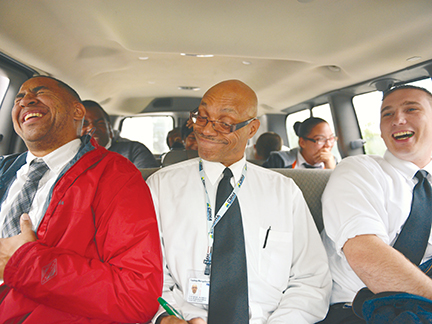
Members of the Cleveland Metropolitan Police force take part in one of the first reverse ride-alongs offered in the Ohio city. Participants tour distressed neighborhoods and meet with people who live with the consequences of economic injustice and work for community betterment.
Reverse ride-along participants talk about the aspirations, assets and challenges of residents of marginalized neighborhoods and the efforts of community members and nonprofits working to improve the quality of life and opportunities.
The participants meet up with more neighborhood residents for presentations and conversations at preplanned stops during the experience. Until his recent departure, Joseph Black led the Sisters of Charity Foundation of Cleveland's program area for health equity. He notes most of Cleveland's neighborhoods are poor and segregated. Many police and providers live outside the city boundaries. Black says, "The neighborhoods of Cleveland face economic injustice because of decades of racist and classist housing policy — including the idea of white flight."
Among the neighborhoods the caravans have visited are Lee-Miles, Glenville, Cudell, Central-Kinsman, Central, Detroit-Shoreway, Asiatown and Slavic Village.
Immersion
Anderson had to be resourceful raising eight children in Slavic Village. Her family endured antagonism and violence as the first Blacks to move into the all-white neighborhood in 1982. A rock thrown through a window of the home struck one of their daughters in the head. Arsonists set fire to the Andersons' home so many times that the insurance company canceled their policy.
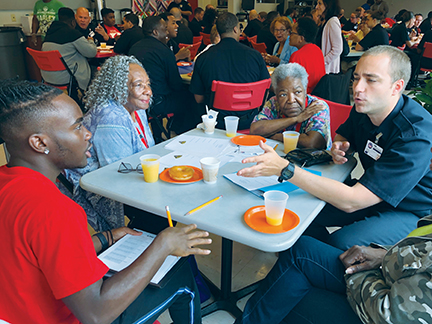
A police recruit, at right, chats with community members during a June 2019 reverse ride-along stop at the Fatima Family Center, a community gathering place operated by Catholic Charities of the Diocese of Cleveland.
The family stood fast, staying in their home for decades even after a nearby factory closed. That closure left many neighbors jobless and set off a cascade of home forfeitures. Lots became overgrown and crime increased as the area deteriorated. A similar downward trajectory befell other Cleveland communities impacted by the loss of industry.
The hardship and racial injustice motivated Anderson's community activism. (See sidebar, page 5.) She has been instrumental in building community support in Slavic Village and other Cleveland neighborhoods, including by founding and running Another Chance of Ohio. The nonprofit operates a store in Slavic Village where all the clothing and merchandise is free for the taking.
Anderson now lives elsewhere in Cleveland. She says she volunteers as a facilitator on the ride-alongs because the immersive experience teaches first responders and health providers about the culture, community and day-to-day lives of people they may later encounter experiencing extreme distress as patients, or as crime victims or perpetrators. Ride-along participants get to know each other as people.

Thrope
Jan Thrope is executive director of Inner Visions of Cleveland, a nonprofit she founded to encourage entrepreneurship and investments in economically depressed neighborhoods in the city. She came up with the idea for reverse ride-alongs and she partnered with the Sisters of Charity Health System's Cleveland Central Promise Neighborhood to make them happen.
She says that during the ride-alongs, "there are moments of real talk, moments of sharing truth, moments that move the needle" in building relationships that positively impact the way program presenters and participants relate to one another.
Trading places
Thrope, a retired social worker and chemical dependency counselor, was working in a homeless shelter in 2006, when Cleveland was ranked as the poorest big city in the U.S. The next year, Thrope began tutoring a 7-year-old boy from Woodland Hills, a neighborhood in south Cleveland. He told her there were many things that frightened him in his neighborhood — an abandoned home, a street shrine to a murder victim, dead dogs rotting on curbs.
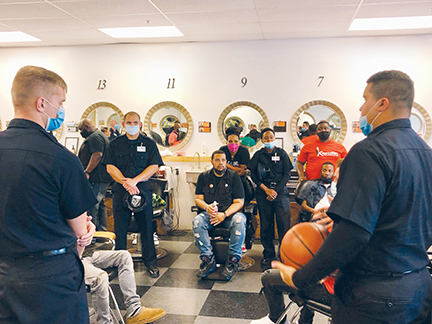
Reverse ride-along participants learn about neighborhood dynamics chatting with locals at The Keratin Barber College in Cleveland in July 2021.
Thrope began exploring Woodland Hills and other poor neighborhoods. She listened to residents about the impact of poverty and heard about how things might be improved. And she took documentary-style photos, which she published along with commentary in her two books on poverty and hope in the urban core of Cleveland.
Thrope began taking teachers, college students and social workers on outings to meet residents in Cleveland neighborhoods who were actively involved in making positive changes in their communities.
When Thrope went on a citizen ride-along with police officers, she realized the police never saw the neighborhoods at their best nor did they have the opportunity to get to know residents under normal circumstances. That's when she hatched the idea to drive police officers around and point out the strengths and potential of some poor neighborhoods.
What began as informal drives through select neighborhoods with police, police cadets and public housing enforcement officers kicked into high gear when Thrope connected with and enlisted the help of Black. He brought the reverse ride-alongs under the auspices of the foundation's Cleveland Central Promise Neighborhood and expanded their ridership to include nursing students, medical residents and other clinicians from around greater Cleveland.
The Sisters of Charity Health System's St. Vincent Charity Medical Center has been an anchor in the Central neighborhood. The hospital closed its acute care services in November and the system now delivers ambulatory care services on the hospital campus.
Since 2017, Cleveland Central Promise and Inner Visions of Cleveland have hosted more than a dozen ride-alongs, reaching a total of about 500 riders. Cleveland Central Promise defines itself as a collaboration of organizations united to improve the health, education, safety and financial security of families in the Central community and beyond.
Black says the ride-alongs allow participants to learn the context of one another's lives and build connections that likely would not happen outside of this program. The program organizers set out to place ride-along participants and community members on equal footing and help them understand each other's point of view. Black says the experience is often as beneficial to the residents as it is to those on the caravans.
Lunching, gardening, painting
Each ride-along begins with participants boarding a convoy of vans, each seating about a dozen adults. During the approximately eight-hour experience, as the vans travel through the streets of multiple neighborhoods, Black, Thrope, Anderson and other facilitators provide commentary on the private and public housing, the community nonprofits, food pantries, churches and informal gathering places.
The caravan makes a couple stops, where Black and Thrope have prearranged meetups. The stops are suggested by community leaders and differ each time.
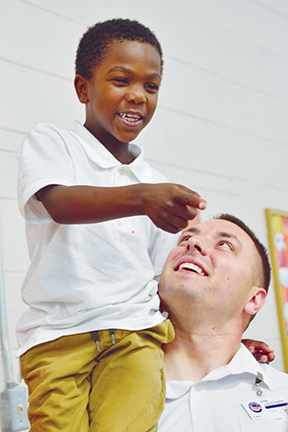
During a June 2019 gathering at the Fatima Family Center, a reverse ride-along participant hoists up a boy who was taking part in the event. The Fatima Family Center is run by Catholic Charities of the Diocese of Cleveland.
Participants have visited day cares, churches, substance abuse counseling services, community gardens, barbershops, a gang prevention program and a homeless shelter. Each meetup stop centers around a group activity. Ride-along participants have lunched, gardened, created murals and danced with community members gathered at stops.
After each stop and throughout the drives, a facilitator in each van debriefs with the riders to process what they experienced. The conversations at the meetups and on the vans can be very vulnerable, authentic, revealing and raw, say the facilitators.
Breakthroughs
Thrope recalls one ride-along where a group of young Black men at a stop talked with the visiting police officers. One young man said an officer's stance emphasized his holstered gun and was intimidating. The officer said he positioned himself that way to lift the weight of his heavy holster off his waist. He'd not been aware his stance came across as aggressive.
During another ride-along, conversation elicited a story from a medical resident who'd treated an impoverished patient. She'd been frustrated with the patient's inability to manage his diabetes and was thrilled when his blood sugar levels finally improved. With emotion the clinician told the group she found out later that the patient's food stamps had been cut off and his blood sugar dropped because he was starving.
Black says beyond talk of difficult life circumstances, residents also share what's good about their community — the deep bonds, life-changing social service agencies, youth pursuing their dreams. The seeds for longer-term relationships bud as community members invite their visitors back, a usual experience on the ride-alongs.
Eye-opening
Dr. Chuck Garven has lived in Cleveland for 60 years. The retired family physician went on a ride-along in March. He wanted to learn more about Cleveland's neighborhoods because he's on a committee that is advising the Sisters of Charity system's leadership during the transition of its St. Vincent Charity Medical Center campus to a community health and social service center.
During the ride-along he met a young mother who said she felt many clinicians with patients from Central don't really care about the people there and that they were not committed to the community.
He says facilitators of his ride-along told him the stereotype of the heartless and unfeeling clinician is common among people who don't trust the health care system. Garven recognizes that he has on occasion relied on stereotypes in making assumptions about people unfamiliar to him. He says the ride-alongs enabled an honest exchange about implicit bias — a step toward moving beyond stereotypes.
"It's an opportunity for folks in the community to get to know each other, whatever their title, and build connections and relationships," he says.
Cleveland community activist pursues racial justice as her life's work
One of the regular facilitators of the reverse ride-along program is a Cleveland resident who had some national prominence because of her efforts to build up challenged urban neighborhoods and fight against exploitation of people who are poor and vulnerable.
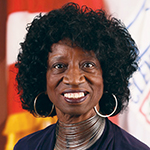
Anderson
Barbara Anderson's influence as a grassroots activist has been fueled by her personal experience of violent racism, and by her perseverance, and by pluck. "I'll just keep moving forward. I don't have all the education; no letters before or after my name; no degree, except for a high degree of mother wit, street sense, common sense and wisdom," she told the author of the bio she provided to this reporter. It encapsulates the 40-plus years she has worked to build up Cleveland's hardscrabble neighborhoods one overgrown lot at a time.
She turned her own pain into righteous action: "I'm just thinking that all my life I have had to experience certain things so that I could properly advocate for others that are struggling," she says in the bio.
Repeated arson
With her second marriage and dual incomes, Anderson and her family bought a home in 1982 in Cleveland's Slavic Village. The first Black family in what Anderson described as a "tight-knit ethnic community," the Andersons were victims of numerous hate crimes.
One night, fires were set at all three exits to her house. "We weren't meant to get out," Anderson says in the bio.
The Andersons instructed their four children to take only one route on their walk home from school so Anderson and her husband would know where to find them. If they did not see their mother waiting on the porch when they got home, they knew to keep moving and get help.
Family tragedy
Anderson's sister was in the final stage of terminal breast cancer around this time and she and her four children moved in with the Anderson family. The Andersons raised the children after the woman's death.
Race-motivated violence escalated as more Black families moved into Slavic Village. In June 1985, an arsonist set a house fire that killed Mabel Gant, who was confined to a wheelchair. That night, Anderson answered the family phone to hear a racial epithet and a threat. The caller said they had gotten Gant and now they'd get her.
"I was fed up," Anderson says in the bio. "It was no longer about me, it was about Mabel."
Anderson's outrage propelled her as she connected with a community-led initiative called National Neighbors that encouraged her to document the assaults on her family. That organization facilitated her appearance on Sally Jessy Raphael's television show and helped her engage in political activism.
In the 1980s she spoke on racial justice and fair housing in Ohio's statehouse and testified in Washington before the Senate Judiciary Committee.
Financial travails
The mid-1990s brought crushing financial strain for the Andersons. The house was falling into disrepair and money was tight. The couple refinanced with an adjustable rate mortgage to free up home repair funds. But then Anderson's husband's health began to fail him and he had to quit his job. When the subprime mortgage crisis hit, the Andersons' mortgage rate reset at an amount they couldn't afford, and the home went into foreclosure.
Almost half the homes in Anderson's neighborhood were in foreclosure. Yards became overgrown, people used the streets as a dumping ground. Prostitutes and drug dealers set up shop.
Still, Anderson wasn't giving up on her house or neighborhood without a fight. She challenged her mortgage servicer and had $20,000 in fees and charges refunded to her. She found a neighborhood bank that agreed to assume her mortgage and convert it to a fixed rate with a monthly payment the Andersons could afford.
She guided neighbors to take similar steps to keep their homes. She testified at community meetings about the dangers of predatory subprime loans. At a 2007 presidential campaign forum she told candidate Barack Obama about the racial injustice inherent in predatory lending. She later was featured in a documentary about the foreclosure crisis, "Cleveland Versus Wall Street."
Anderson started a neighborhood betterment club that did cleanup work, created a neighborhood garden, cut lawns at abandoned properties and organized street parties. The club set up surveillance cameras for use in monitoring and reporting drug dealers. Unarmed neighborhood men patrolled the area. Anderson helped folks from other neighborhoods launch similar neighborhood protections. For her efforts she was named to People magazine's "Heroes Among Us."
— JULIE MINDA